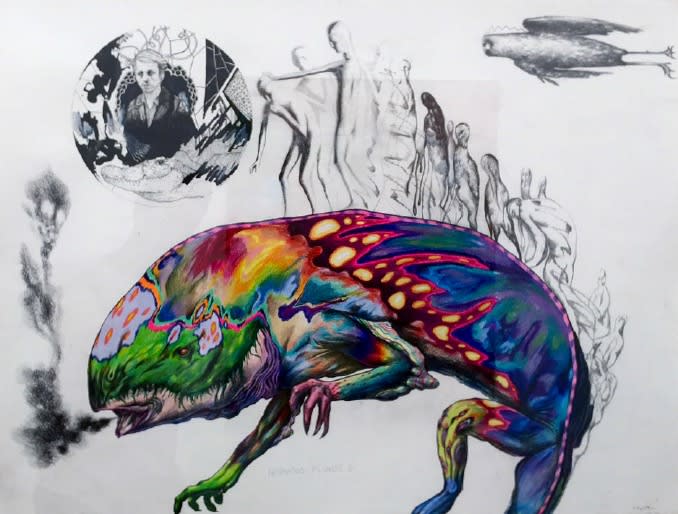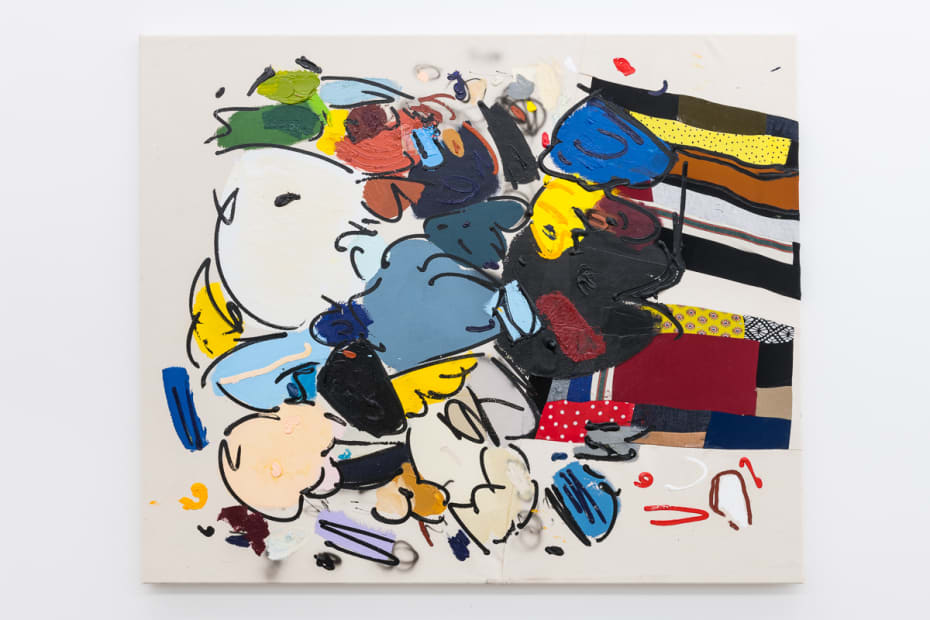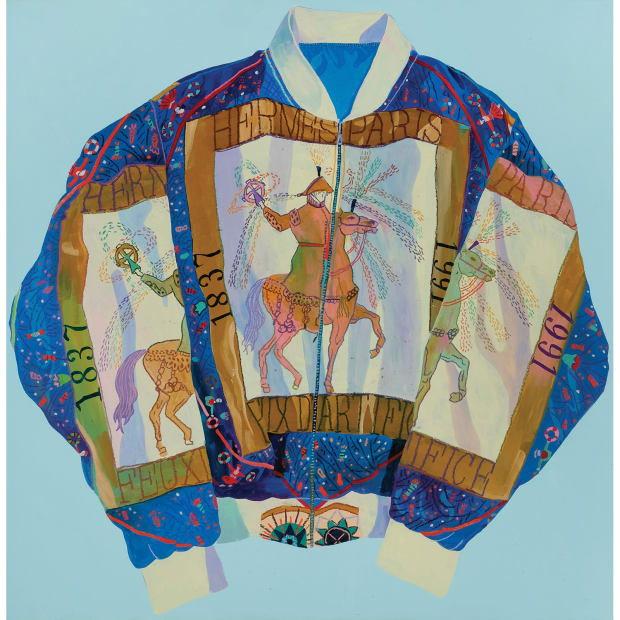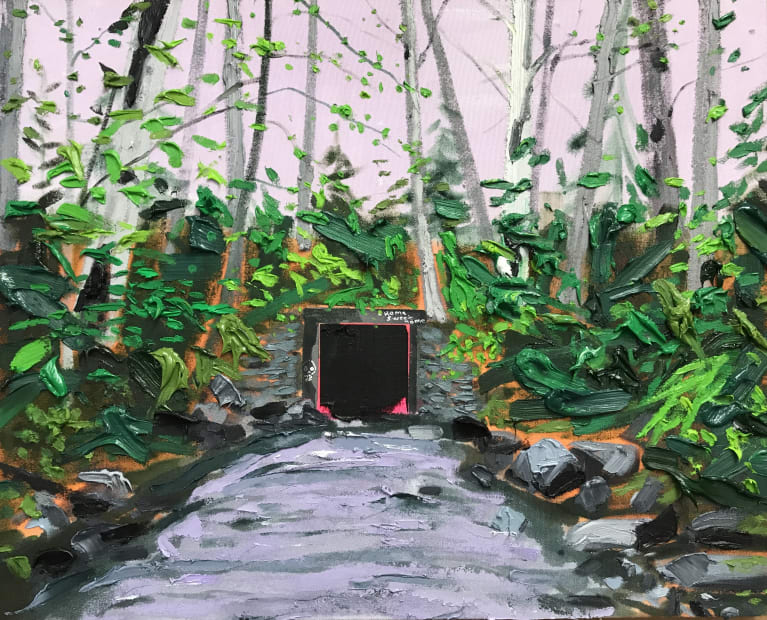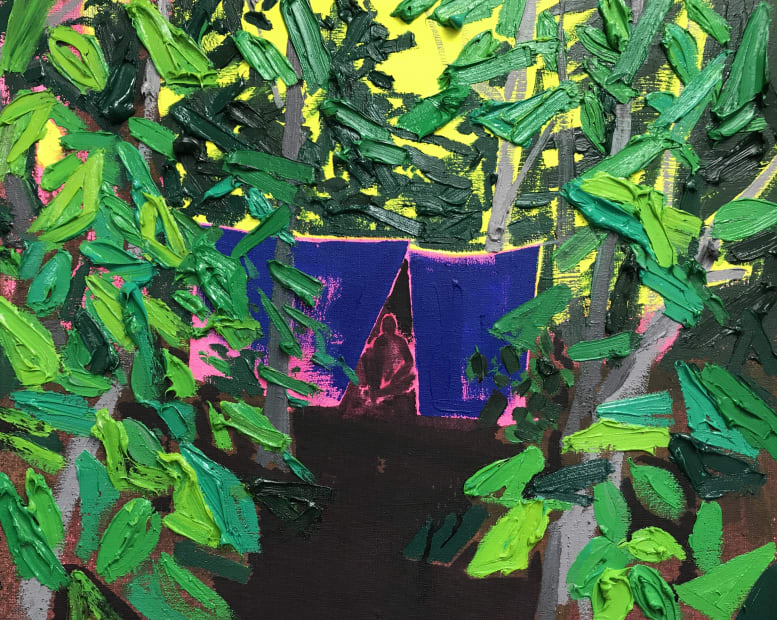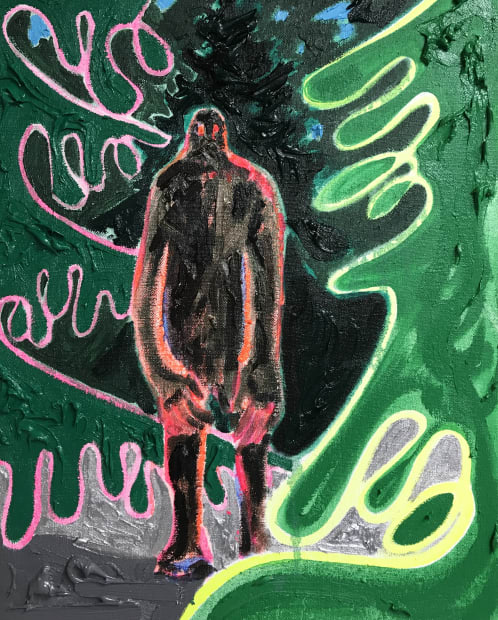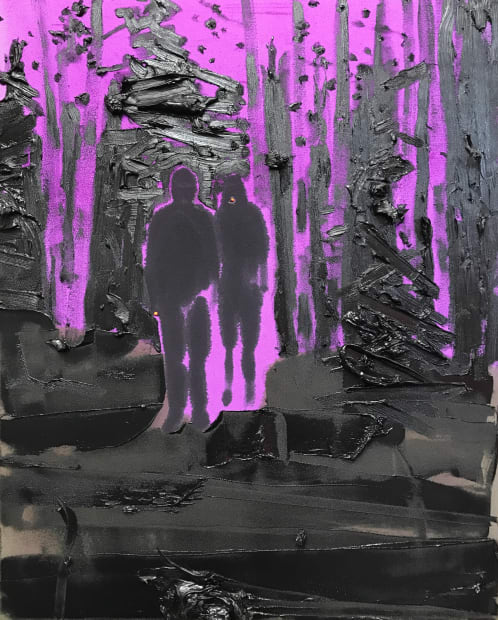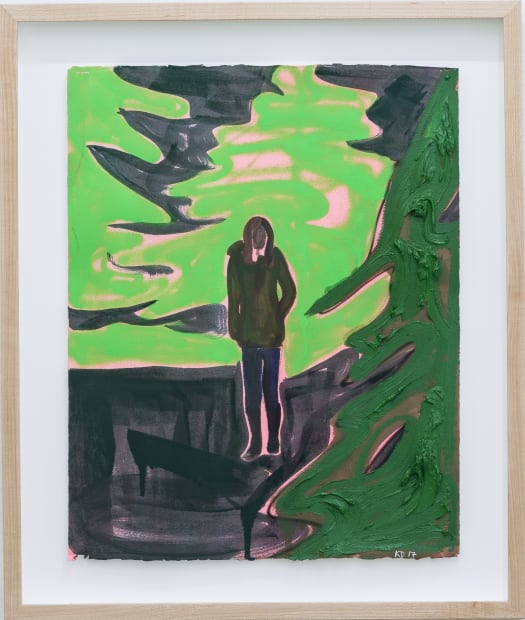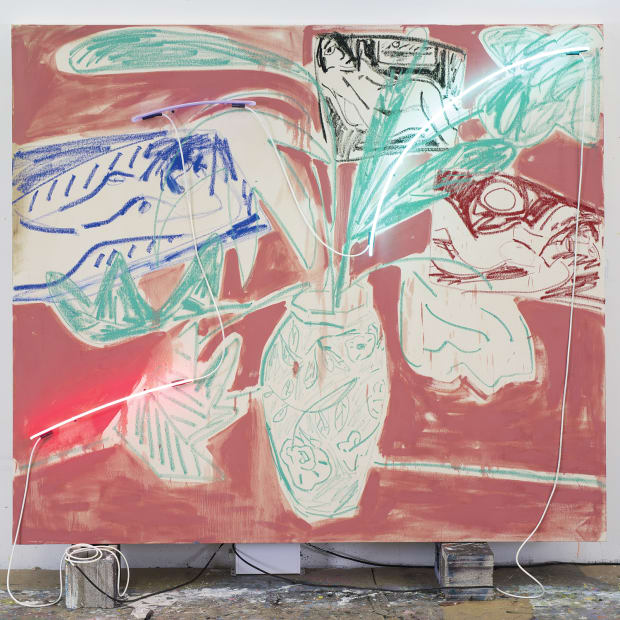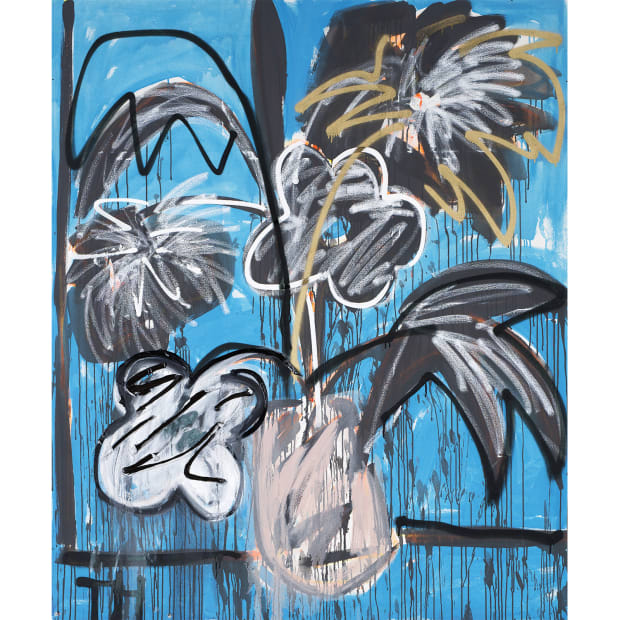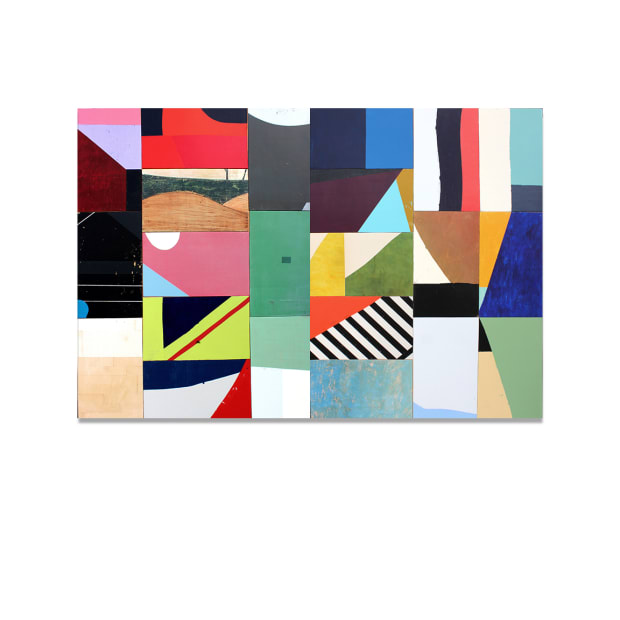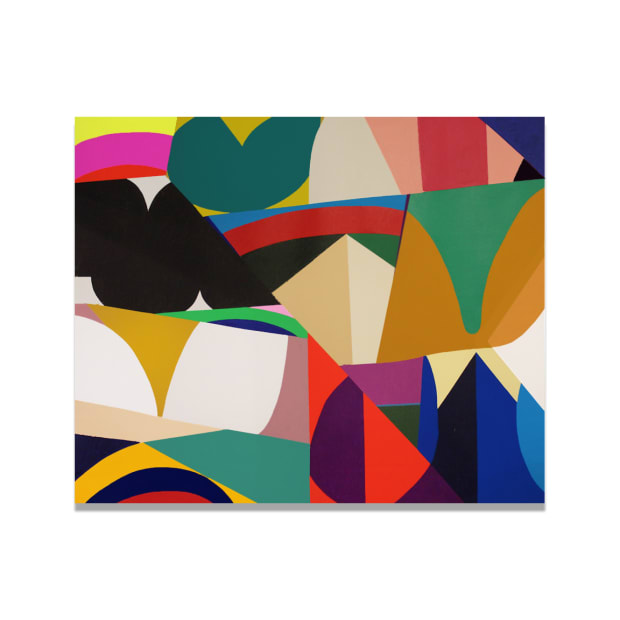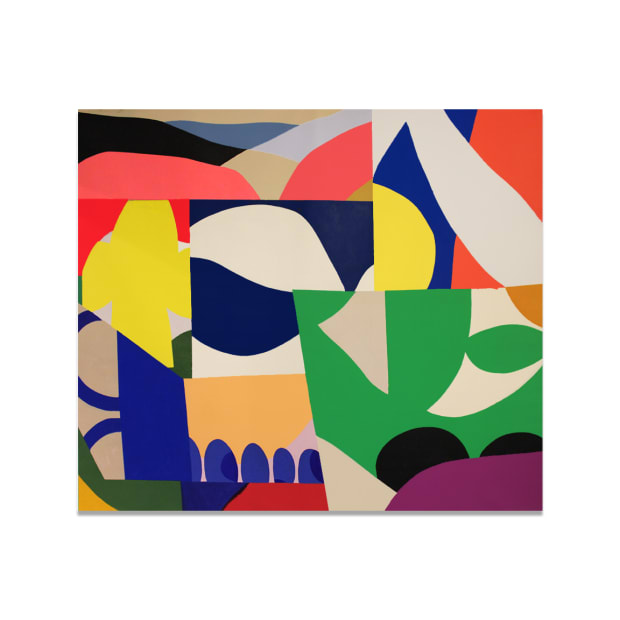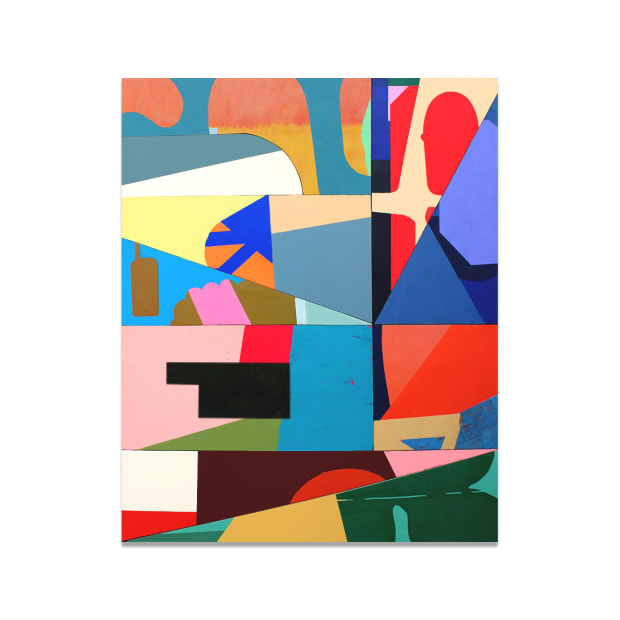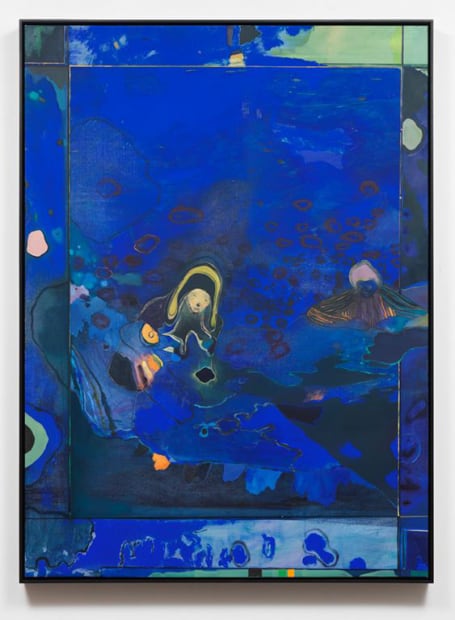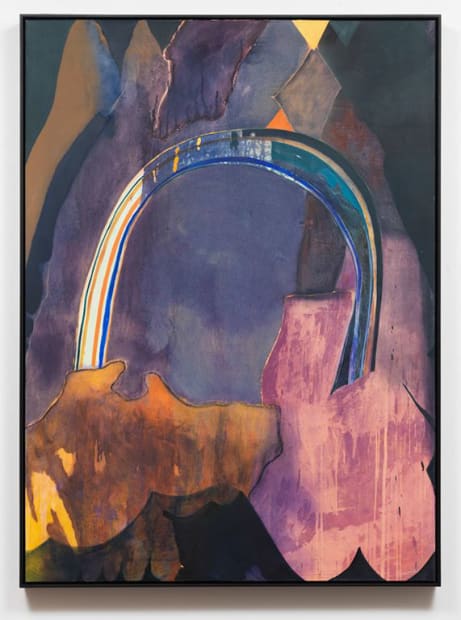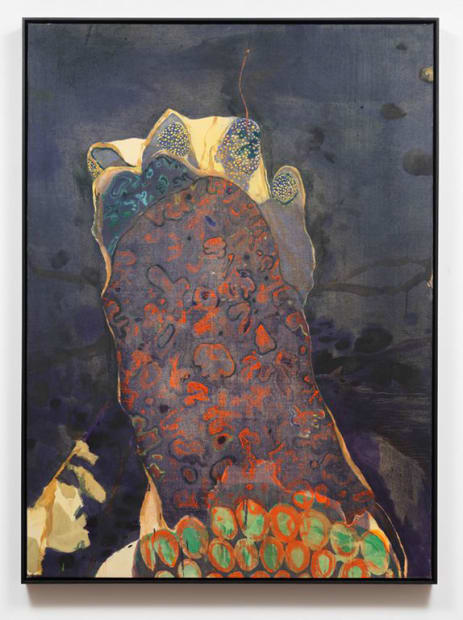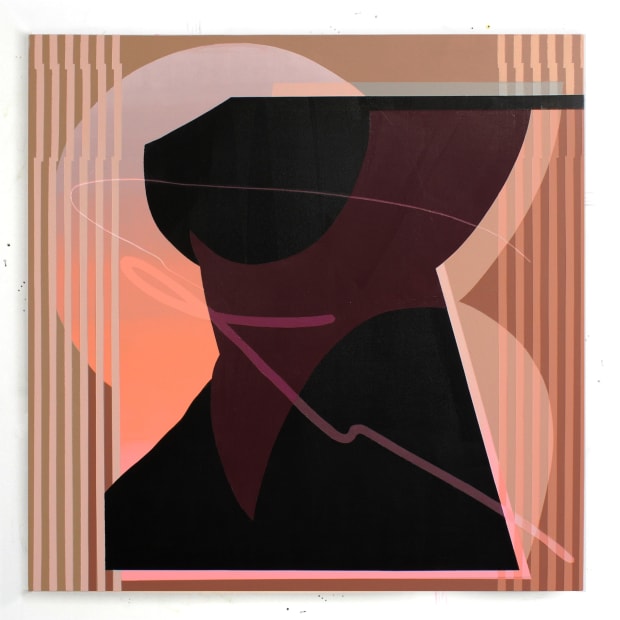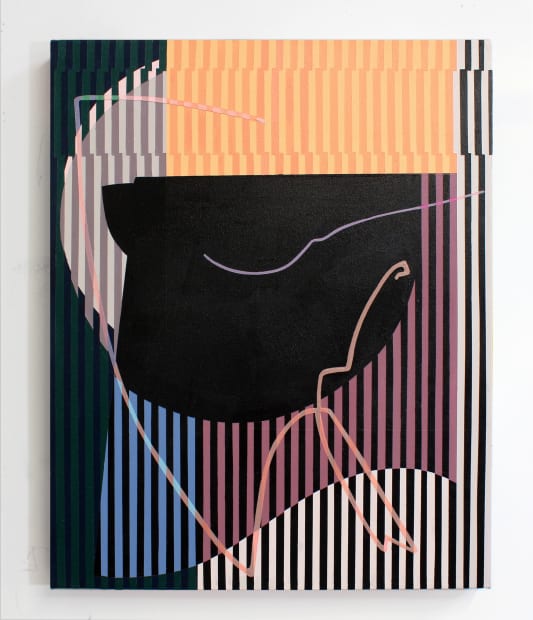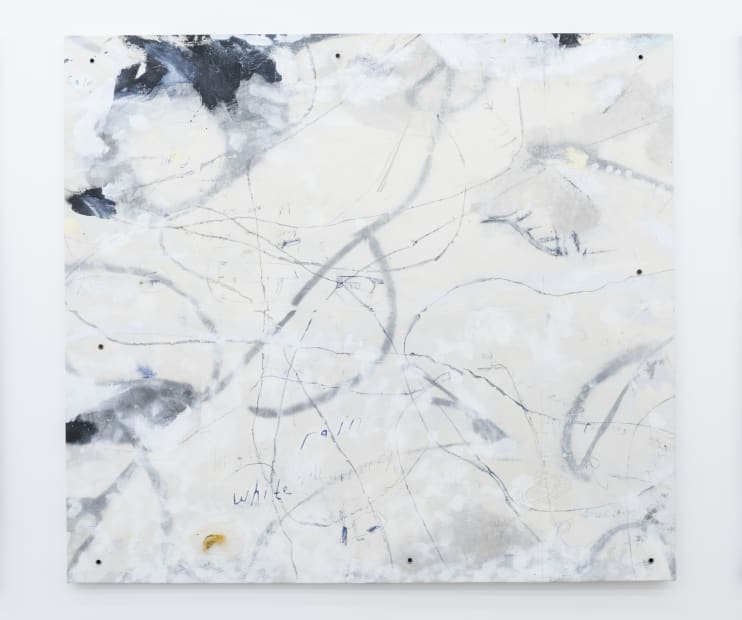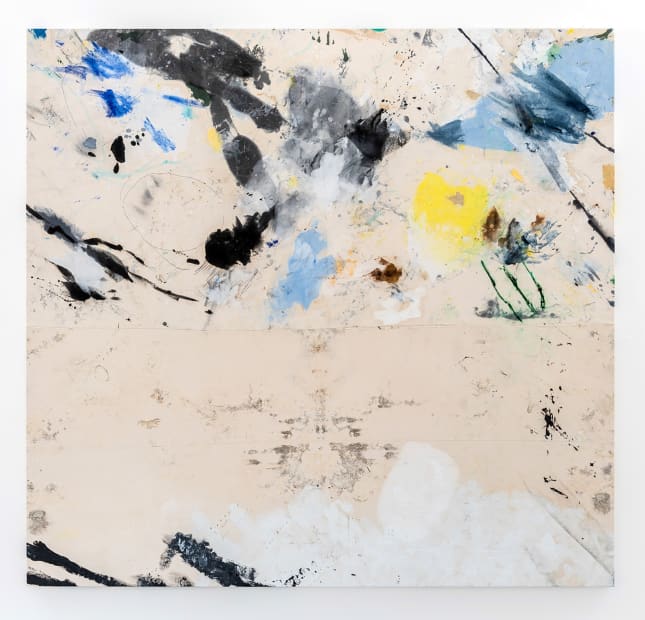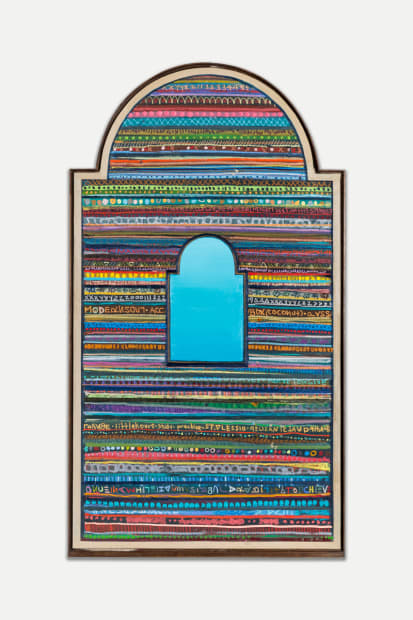SUMMER SALON
BEERS London’s Summer Salon brings together a collection of works by gallery represented artists for those sleepy days over the summer. Presenting a combination of new, never exhibited, as well as previously exhibited works, this marks the first time all gallery artists will show a piece together at the same time.
SVERRE BJERTNES
Sverre Bjertnes is a rising star of Norway’s contemporary art scene. With works in the mediums of drawing, painting and sculpture, he is particularly interested in the act of exploring the creation of the works as they unfold, as well as the aesthetic experience of the viewer as they traverse from the figurative to the literal. This mode of thinking results in works which are both realistic and abstract in equal measure, transporting the viewer to a place where the familiar and the unfamiliar melt into one and can be viewed entirely subjectively.
JONNI CHEATWOOD
Jonni Cheatwood is a Brazilian-American visual artist working across many different disciplines including painting, photography, graphic design and textile art. Cheatwood’s work describes the broad visual ideas stemming from still life, abstraction and minimalism, but his approach is a wonderful amalgam of his artistic disciplines in which veritable scraps of canvas are hand-sewn together before his idiosyncratic mark-making is thereafter applied to the newly created surface. Denim, mesh, burlap sacks, t-shirts, blankets, t-shirts, screen-prints, and even his father’s worn leather satchel have all made their way into his work at one time or another. The graffiti-like scribbles, scratches and primitive colours of Cheatwood’s work is the controlled chaotic work of an erudite expressionist brought up on Saturday morning cartoons; suggesting deconstructed contour lines and bright, unforgiving primary colours often applied directly from the tube or oversize pastel. Beginning with direct marks, squiggles and doodles, Cheatwood reacts and builds up his compositions over time, working with the studio detritus that can build up as a result of working on the floor and from the physical nature of his process – allowing this to become part of his formation of the work. The many references housed in his work – whether intentional or unintentional – seem like a patchwork of Cheatwood’s own autobiography – and the works come across like humorous albeit highly personalized recollections of his life at various times.
JONNI CHEATWOOD (b. 1986, Thousand Oaks, CA) lives and works in Los Angeles, California. He graduated from Arizona State University, Tempe, in 2011. Solo exhibitions include: Galerie Dutko, Paris, France (upcoming); Urban Spree (residency), Berlin, Germany (upcoming); That’s Dallas Baby, Artual Gallery, Beirut, Lebanon (2019); Dressed Up for the Letdown, Over the Influence, Hong Kong, (2018); She’s Heavy on the Razzmatazz, Makasiini Contemporary, Turku, Finland (2018); Same Hero, New Boots, TW Fine Art, Brisbane, Australia (2018); Strange to Meet You, Tappan Collective, LA (2017); Don’t Life Your Heroes up so High, Palabra, Phoenix AZ (2015); and Alysian, Prohibition Gallery, Culver City CA (2014). Group exhibitions include: Seven Days Are Too Long, Mirus Gallery, Denver, Colorado (upcoming); The Atlantic Bridge, Galerie Kremers, Berlin, Germany (2019); Office Hours, New Museum, Los Angeles, California (2018); View From the Cheap Seats, Chimento Contemporary, Los Angeles, California (2018); The Urban Experience, Artual Gallery, Beirut, Lebanon (2018); FRESHAF, TW Fine Art, Brisbane Australia (2017); and Buy What You Love, Rema Hort Mann Foundation, New York NY (2017). Cheatwood first exhibited with BEERS London for the group exhibition 75 Works on Paper (2017), and exhibited at Volta NY with BEERS in March 2018.
ANDY DIXON
Andy Dixon’s work is consummately aware of the art-world’s relationship with money. His large, instantly recognizable paintings often retread similar subject matter and themes: lavish (Dutch-influenced) still lives, reclining nudes, ornate ballrooms, bathing beauties, or – most recently – paintings of patrons’ homes (where his own paintings feature prominently on the walls in the background), paintings of ‘fancy things’, or of fashionable garments: most notably his recent collaboration with fashion house Versace, resulting in an oversized (2 metre tall) Versace shirt, and even a line of luxury bedding released by the brand. Borrowing content from Renaissance and Rococo art, Flemish still-life tradition, a loose yet definitive style that is both Classically informed and contemporarily irrelevant, his own work asks, “What is the value of a painting of a valuable object? As Alex Quicho writes in Luxury Object, Luxury Subject, “His postmodern non-interest in either vilifying or reifying luxury cooly transmutes its weirdness.” A self-taught painter and former punk-rocker, his own persona projects from his work – like a modern-day Andy Warhol, and Dixon situates himself somehow as a critical but complicit player within a larger arena. His treatment of the high-brow content in a crude manner, matching a vivid pastel palette with rough line treatment, brings this tongue-in-cheek awareness to the forefront. His practice has recently expanded to include 3D sculptures which mimic the figures in his paintings—absurdly disproportionate, yet still created with an eye toward beauty. In this way, Dixon’s own appreciation of his subject matter is evident; and while his work questions the subjective valuation of artwork, it also proves that it doesn’t necessarily detract from its beauty.
ANDY DIXON (b. 1979, Vancouver, Canada) lives and works in Los Angeles, California. Solo exhibitions include: Look at This Stuff Isn’t It Neat, Joshua Liner Gallery, New York (2019); Alchemy, BEERS London, London, UK (2018), On the Ceiling of my Suite in the Royal Palace, Wilding Cran, Los Angeles (2018); Expensive Things II, Winsor Gallery, Art Toronto (2016); Expensive Things I, Winsor Gallery, Art Toronto (2016); and Leisure Studies, RHG, New York (2015). Group exhibitions & fairs include: 10 Year Anniversary, Joshua Liner Gallery, New York (2018); Drawing Room, OTI, Hong Kong (2018); How Much do They Cost?, PULSE Miami Beach with BEERS London (2018); O Canada, BEERS London, London, UK (2017); Pronk, Volta New York with BEERS London (2017); New York (2017), Art Seattle, Windsor Gallery, Seattle (2017); and Art Toronto, Windsor gallery, Toronto (2016).
KIM DORLAND
Kim Dorland’s works remind us of the power of nature and the impact that humanity has upon our environment, present, and future. His paintings are typically inspired by the landscapes of his native Canada, as well as more traditional landscape painting and portraiture such as that explored through Tom Thomson, of Canada’s famed Group of Seven who painted in the early 20th Century. But what is perhaps most indicative of Dorland’s trademark style is a seemingly post-punk aesthetic: like glowing embers from a fading campfire, Dorland’s tableaux suggests the harsh burn-out of a long party, a suburban riot, or a torrid affair – a recent self portrait was titled Self at 44 – perhaps suggesting an awareness of time and mortality. Just as Neil Young continues to release rock-music tinged with his experience, so to does Dorland release paintings where the party-haze seems to have mellowed. Through their use of bright colours and thickly impasto paint, Dorland’s scenes often depict a relatively tongue-in-cheek idea of modern life versus nature: graffiti-ridden walls, bridges encroaching into the wilderness, sunrise in suburbia littered with beer bottles, or trunks of trees with expletives ‘carved’ into their bark with paint. There is a cheeky, albeit sinister undertone to his perspective, but the work is levied by its sense of humor, colour-use, and apparent irreverence. Even his figurative work operates similarly, where portraits of friends or family members emerge almost conceptually: often through a vigorously applied mountain of paint, as though the paint were a type of metonym or stand-in for memories. Other times, faces are ghostly, shadowed or obscured behind hoods and blankets. Applying paint in a fevered, immediate manner, Dorland uses a combination of flattened acrylic grounds layered with viscerally and liberally applied oils. Lately, his approach combines ‘digital painting’ with his instantly recognizable style. These are paintings that prefer to elevate their medium – as opposed to their subject matter: Dorland has alluded to celebrated painter Frank Auerbach as a pivotal, early influence, stating he’d “never seen anything like it, the way the material looked and felt. It was sort of icky’. Like Auerbach, Dorland paints his subjects with a sense of freedom from traditional representation combined with an unsettling, almost violent immediacy – usually typified by his signature neon underpainting or application of a wide array of circulating motifs: butterflies, trees, skulls, plastic-bags, self-portraits, even a hazmat-suit here or there. All of this growing mythology seems to provide – for both artist and viewer – a method of exploring humanity and the uncanny while simultaneously keeping it at a curious psychological distance.
KIM DORLAND (b. 1974, Alberta, Canada) lives and works in Vancouver, Canada. He graduated with an MFA from York University, Toronto, in 2013, and a BFA from Emily Carr Institute of Art and Design, Vancouver, in 1998. Solo Exhibitions include: It Goes On, Equinox Gallery, Vancouver, BC (2019); Same Old Future, Arsenal Contemporary, New York City (2018); Terror Management Theory, BEERS London, London, UK (2018); Nemophilia, Equinox Gallery, Vancouver (2017); Get Out, Galerie Antoine Ertaskiran, Montreal (2017); and I know that I know Nothing, Angell Gallery, Toronto (2016). Group exhibitions include: Patel Inaugural Exhibition, Patel Gallery, Toronto (2019); Aidas Bareikis, Kim Dorland & Bill Saylor, Mier Gallery, Los Angeles (2016); and Major Works, Equinox Gallery, Vancouver (2016). Art fairs include: The Papier Art Fair with Patel Gallery, Montreal (2019); Untitled Miami Beach, (solo) with BEERS London, UK (2018), Art Toronto with Galerie Antoine, Toronto (2018). Dorland was the Globe and Mail’s ‘Artist of the Year 2013’. His works can be found in the collections of the Art Gallery of Alberta, Musée D’art Contemporain De Montréal, The Beth Rudin DeWoody Collection, The Richard Prince Collection, the Taschen Collection, Takashi Murakami; Contemporary Art Foundation (Japan); and the Audain Art Museum. Dorland’s first group exhibition with BEERS London was O Canada! (2017).
THRUSH HOLMES
THRUSH HOLMES (b.1979, Canada) Holmes’ previous solo exhibitions include Heavy Painting and More at the Mike Weiss Gallery, (New York, 2014) Break Room, at Next Lounge at the Toronto International Art Fair (2014), VOLTA NY courtesy of Mike Weiss Gallery, New York All Lit Up on Wine, (Mike Weiss Gallery, New York, 2013) Flames Up (Angell Gallery, Toronto, Canada, 2013), Noiseless Moon (Angell Gallery, Toronto, 2012) Big Bad Motherfucker In Charge (Neubacher Shor, Toronto, 2010), New Luxe and Paintings; Some Good, Some So-So (T.H.E, Toronto, 2010). Some of his earlier solo shows include Big Paintings (T.H.E, Toronto, 2009) Every Million Golden Universe (T.H.E, Toronto, 2008), We Are All Images and MYTH ME (T.H.E, Toronto, Canada, 2007) and New Paintings (Drabinsky Gallery, Toronto, 2006). He has also been part of a number of group exhibitions, most recently, I want that inside me by Feature Inc in New York. Holmes’ work has been critically acclaimed in articles in numerous publications including Whitehot, The Globe and Mail, Nuvo and Arte Fuse.
WILLIAM LACHANCE
William Lachance is best known for his brightly coloured abstract work. His ‘constructed paintings’ are often labour-intensively created from a combination of paint on canvas that are re-sewn together, or in other instances, a multitude of painted wooden segments are broken down and reconfigured like a giant jigsaw puzzle. Most recently, he has been experimenting with sculpture, exploring how his works can expand into totem-like pillars that exemplify his keen sense of humor and the proficiency with which he plays with colour and pattern combinations. Lachance also expounds his work into the world – and his instantly recognizable aesthetic has been applied to murals, brand-marketing, and most notably, to revitalize inner-city basketball courts for disadvantaged youth with the charity Project Backboard. The works take their cue from the immediacy of signs, symbols, and semiotics in contemporary consumerist culture – including vintage graphic design, and illustration. Most often, however, LaChance keenly explores the enveloping space behind and around isolated areas, forgotten locations, and anti-spaces: a kind of revitalization of the dystopian – from airport parking lots to now defunct Modernist architecture. There is a Romanticism to LaChance’s approach, a desire to embrace and to look beyond what is depicted and to create a new-found language for these disparaged sites. And while Lachance’s abstract paintings create a seductive, wholly gleaming surface, they maintain a subtle subversion of their sources, a sort of wry, keenly aware critique of the appeal of the mass produced – as though critical of a futurist vision of society while functioning within it.
WILLIAM LACHANCE (b. 1971, St Louis, Missouri) lives and works in St. Louis, Missouri, USA. He graduated with a BFA from The Kansas City Art Institute and MFA from Indiana University. Solo exhibitions include a Crossroads Location, Haw Contemporary, Kansas, USA (2019); a debut with Madison Gallery, San Diego (2019); a booth-wide installation at Expo Chicago with BEERS London (2018); After Edge City, BEERS London, (2018); Art Athina, Athens, Greece (2017), Rod Bianco Gallery, Oslo, Norway (2017), Direktorenhaus, Berlin, Germany, (2017), Junior Space, Melbourne, Australia (2017). Group exhibitions include: R/SF Projects, San Francisco (2018); and The Hole, NY (2017). He has been featured extensively in both online and printed press. He first showed with BEERS London in the group show 75 Works on Paper (2017) and continues to maintain an active schedule with the gallery at both international art-fairs and gallery exhibitions.
ADAM LEE
Adam Lee works from his studio in the hills of the Macedon Ranges, Victoria, Australia, and he works mostly with traditional painting and drawing materials. His work references a wide range of sources including historical and colonial photography, biblical narratives, natural history, and most recently seem to embody more imagined or fantastical sources, investigating aspects of the human condition in relation to ideas of temporal and supernatural worlds. There is a sort of unsettling stillness to Lee’s work, a type of peaceful disquietude, where figures are situated in strange, unearthly spaces seem to tend to their own spiritual procession. As his practice has moved from more traditional ‘landscape’ painting to a practice that incorporates more emotive, poetic and narrative qualities, the work seems laboured upon with an almost religious reverence – somewhere between RB Kitaj and Rothko, oddly enough. There is a stylization of all Lee’s forms – where the figures become almost crystallized – and the viewer senses the creative and critical processes Lee undergoes to create his distinct bodies of work. From hunters, to shamanism, to fatherhood, Lee’s themes result in an informative nucleus from which he works prolifically to create large paintings and drawings that respond to a central theme. As viewers, we become complicit to the world he creates.
ADAM LEE (b. 1979, Melbourne, Australia) lives and works in Macedon Ranges, Victoria, Australia. He obtained a PhD from Royal Melbourne Institute of Technology in 2015, and graduated with a Masters by Research and Bachelor of Fine Art from the same university in 2006 and 2002 respectively. Solo exhibitions include: Stratum with Jon Cattapan, Station, Melbourne (2019), Monolith, Gertrude Glasshouse, Melbourne (2018), Lament Asunder (All is Dark is Midnight to Me), Station, Melbourne (2017); Of a Great and Might Shadow, Angell Gallery, Toronto (2016);. Eden. Exile. Babel, Station, Melbourne (2015), Into the Heart of the Sea and to the Roots of the Mountains, Kalimanrawlins, Melbourne (2012), The World Travailing, Kalimanrawlins, Melbourne (2011), And They Built for Themselves Kingdoms, Tristian Koenig, Melbourne (2011). Group exhibitions include: Shanti Shanti Shanti, Station, Melbourne (2018), Sirens (I Heard Voices In The Night), Gertrude Glasshouse, Melbourne (2016), 35 Works on Paper, BEERS London, UK (2016), Angell Gallery’s 20 Year Anniversary, Angell Gallery, Toronto, (2016), I Heart Painting 2, Angell Gallery, Toronto (2015); In the Dust of This Planet, Station, Melbourne (2014); Ready Player One, Station, Melbourne (2013), and Art Stage Singapore (with Karen Black), Tristan Koenig Gallery, Singapore (2012). Lee has been shortlisted for numerous awards including the Geelong Contemporary Art Prize 2014, The Arthur Guy Memorial Painting Prize 2014, the Sulman Prize, the RBS Emerging Artist Award, the Rick Amor Drawing Prize, the Mornington Peninsular Drawing Prize, the Redlands Westpac Art Prize and The Churchie National Emerging Artist Award. In 2017 he was the inaugural recipient of the Glasshouse Stonehouse Residency in France. The first monograph of his work, Votive, was published through Perimeter Books in 2018. Lee’s first group showing with BEERS London was in The Fantasy of Representation, London (2015). His solo exhibitions at BEERS London include A Long Obedience, London (2015), and This Earthen Tent, London (2017). Adam will be having his third solo exhibition with BEERS London in October 2019.
KATHRYN MACNAUGHTON
Canadian artist Kathryn MacNaughton deftly interweaves figurative painting with a combination of abstract expressionism, geometric abstraction, and even conventions of the painted still-life into one poetic statement. Here, these forms of figuration and still life have been flattened, like their more abstract counterparts, to face the frontal plane of the canvas. In this sense, the canvas – and the analog process of the painter’s hand – references the computer screen and the digital touch, where these pieces originally begin to take their shape. She states: I wanted my digital work to look raw and handmade. Now that I create “physical” paintings, I want to give the illusion that the work is digital. MacNaughton, who trained and worked as a graphic designer, uses this sort of ‘digital compression’ to her advantage, and one begins to use typically post-analog language when discussing her work: masking, layering, colour-blocking, silhouette. Here these concepts are paired with more Romantic expressive movements: a scribble dances across a bust, outlined in silhouette, which guides the viewer’s eye around the flattened curves as one guides the finger across a map. The work simultaneously houses a sensuality one aligns with gender tropes: as suggestions of feminine curves play shadow-tricks, appearing as vessels or curtains that guide the eye, but also obscure and reveal the picture plane while painterly splatters and curves leap behind and before the picture plane. But also the masculine, referencing brutalist and Modernist architecture: the austerity and monolithic qualities of shape, form, and line, or perhaps even the sharp angles of cacti in the desert. We see references from Robert Morris to Georgia O’Keefe; Diebenkorn to DiChirico, and even a cheeky reference to the highly stylized drawings of Patrick Nagel (more colloquially known as the artist who made Playboy ‘drawings’ iconic of the entire 1980s). The work therefore works in polarities: analog and post-analog mark-making (ie: the painterly and the digital); feminine and masculine; pragmatism and Romanticism; expressiveness and obfuscation; light and dark. There is a sense of theatricality to her revelations, and it is, in every sense, a cheeky play of light and dark versus form and technique, like boxing with one’s own shadow – an art of individual, delicate mastery.
KATHRYN MACNAUGHTON (b. 1985, Toronto, Canada) lives and works in Toronto, Canada. She graduated from Ontario College of Art and Design in 2007. Solo exhibitions include: Intervals, BEERS London, London (2018), Fixed State, Bau Xi Gallery, Toronto (2018); Sprang, Bau Xi Gallery, Toronto (2016); and Blue Note, Huntclub Gallery, Toronto (2015). Group exhibitions include: Pour, Joshua Liner Gallery, New York (2019), Your Favourite Artist’s Favourite Artist II, Joshua Liner Gallery, New York (2019), Dualities: A Bridge Between Two Worlds, Bau Xi Gallery, Toronto (2017); Smash, Gardiner Museum, Toronto (2016); and The One That Got Away, Artscape Youngplace, Toronto (2015). Macnaughton’s work has been featured in publications such as Elle Magazine, District-W Magazine, and The Coveteur. Art fairs include: Zona Maco, Mexico City (2019) with BEERS London.
PETER MATTHEWS
Peter Matthews’ approach to art-making is entirely unique: he travels the world, ocean to ocean, where he then creates a make-shift drawing-table/flotation-device upon which he will abscond himself – for hours at a time – in the ocean, recording what he sees and experiences in a stream-of-consciousness manner. Most recently, his works are thereafter torn into shreds upon the beach, where he sits throughout the day restitching the works into complete pieces to be mounted upon a canvas when he returns to his native UK. Through the simplicity of the works, Matthew’s comments as much on performance and ‘the conceptual’ as he does the two-dimensional picture plane. For these are paintings that are not really about painting at all, but rather about man’s inability to recapture the momentary sublime held in the vastness of nature, the bleak romanticism in the ocean as it consumes and intoxicates. Through extended hours (sometimes up to 12 hours adrift, alone at sea,) Matthews is working in real time through a very direct approach and immediate relationship with the ocean, where it becomes evident that his process is so much less about draftsmanship or material and more about an idea connected to nature and personal spirituality. Matthews seeks to question and challenge the nature of the artwork, whether an artwork can approach the metaphysical, and even momentarily take us closer to nature with him. There is an immediacy and connectivity in Matthews’ practice that articulates something that even a painting cannot – for a painting is about production, and these drawings are not about the artist’s studio or statement: they are about a place and moment in time. Most recently, he has begun pairing his works with videos which offer perhaps the most straightforward documentation of a practice defined by its very indefiniteness, its incalculability, and the presence of video may be more apt to contextualize something beautiful and profound that art-making, even after hours and hours drifting in the ocean, may not be able to fully explain for his viewer.
PETER MATTHEWS (b.1978, Derby, England) lives and works in Leicester, England. He graduated with a BA in Fine Art with honours and an MFA from Nottingham Trent University. Solo exhibitions include The End Is Where They Start From, BEERS London (2019); Pasaje Montoya, Barcelona, Spain (2018); From the Pacific to the Atlantic, Strange Cargo, Folkestone, Kent (2017); In Search of the Sublime, BEERS London (2016); Surroundings, BEERS London, (2013); Continuum, James Cohan Gallery, New York (2011); and Sea Marks, Mendes Wood DM, Sao Paulo (2011). He was a 2014 finalist in the Francois Schneider Contemporary Talents competition in France. In 2015, he completed an artist resident at the Scripps Institute of Oceanography California, and was also shortlisted on the Sky Arts programme ‘Landscape Artist of the Year’. In 2017 he was awarded the Hugh Casson Drawing Prize at Royal Academy of Arts, London. He was selected for the John Moores Painting Prize in 2018, and also showed a large body of works on paper at the Saatchi Gallery, London in the spring, curated by Sacha Craddock. His works have been collected by the Coppel Collection, The National Maritime Museum, and various other public and private collections internationally and throughout the UK. Matthews’ fair history includes a solo showing with BEERS London at Artissima, Torino (2016) and a group presentation at Zona Maco, Mexico City (2019). Upcoming exhibitions in 2019 include a major installation at the Royal Museums Greenwich’s National Maritime Museum in June, supported by the Arts Council of England, and an institutional solo show at the Hiroshima City Hall in Japan in the autumn supported by the Daiwa-Anglo Japanese Foundation. Matthews is a 2019 recipient of a Winston Churchill Memorial Trust Fellowship, which will see him undertake a major new body of works across the Pacific and Atlantic coasts of the USA in the summer of 2019.
ANDREW SALGADO
Andrew Salgado’s paintings have evolved greatly in style since first rising to prominence over half a decade ago with his (then) signature large-scale, painterly portraits, where large swathes of colour played across the surface to define his subjects. In his most recent work – the representational has given way to the more abstract: and now such colourful, symbolic, and compositional elements are the driving force of the painted image. While the figures remain a common thread – today Salgado’s subjects are depicted in a fantastical, often ominous tableaux. There are abundant references to the tradition of figurative painting both historic and contemporary: Matisse, Gauguin, and Bacon are all readily recalled; while contemporary greats like Tal R, Daniel Richter, and Peter Doig are also referenced with equal reverie and respect – often like quiet in-jokes for a viewer to catch. The artist’s long-standing tendency to paint clowns and the absurd remain constant (in 2016’s The Fool Makes a Joke at Midnight, the artist had actual circus performers in the exhibition space during the exhibition’s duration), and again one sees faces are painted in bright orange, with purple noses and vibrantly coloured hair. Where there once was a plain background, which placed the figure at the forefront of the image, now there is a kind of harmonious cacophony, a medley of pop-coloured squiggles, harlequin patterns, and wonky block shapes–all of which may seem hastily scribbled if it weren’t for the fact that they slot into one another like an impossibly orchestrated puzzle.
Salgado’s more recent works have made a noted effort to distance himself from a 2008 assault (in which he was attacked for being a gay man), and are decidedly certainly more irreverent than his previous offerings: brighter, more celebratory, even theatrical. The artist carries this sense of play into his exhibitions, too. For The Snake (BEERS London, 2016), hundreds of butterflies were released to flutter amongst the audience as if they had burst from the artworks themselves; A Room with a View of the Ocean (Lauba House, 2017) saw an 8-metre ocean projection (and artificial ‘beach’) on the final room’s wall, inviting the audience to partake in a meditation of what they had seen; and the two-day-only exhibition Nature Boy (BEERS London, 2018) saw a pianist (at a baby-grand!) playing the eponymous song on repeat for the entirety of the show’s duration. For Salgado, similar to his increasing use of collaged elements, an exhibition is an opportunity to extend elements of the painting beyond the canvas–an invitation into his world of colour, fantasy, and fun.
ANDREW SALGADO (b. 1982, Regina, Canada) lives and works in London, England. He graduated with an MA in Fine Art from Chelsea College of Art and Design in 2009, and has since had 13 sold-out solo exhibitions held all over the world, and is widely regarded as one of the UK’s leading young figurative painters. In 2017, Salgado was the youngest artist to ever receive a survey-exhibition at The Canadian High Commission in London, accompanied by a 300-page monograph, both of which were entitled TEN. Previous solo exhibitions include, Blue Rainbow, Angell Gallery, Toronto, (October 2018); Nature Boy, BEERS London, (2018); Dirty Linen, Christopher Moller Gallery, Cape Town (2018), A Room with a View of the Ocean, Lauba Art House, Zagreb (2017); The Snake, BEERS London (2016); The Fool Makes a Joke at Midnight, Thierry Goldberg, New York (2016). He has exhibited his work at various international art fairs, including Zona Maco, Mexico City (2019); Pulse Miami (2016); and Volta Basel (2015). In 2015, Salgado curated The Fantasy of Representation, including work by Francis Bacon, Gary Hume, and Hurvin Anderson, with an impassioned manifesto on representational painting. In 2014 he was the subject of a documentary, Storytelling. He has received extensive press both online and in print, including GQ, The Evening Standard, The Independent, Artsy, METRO, Attitude Magazine, Globe and Mail (CAN) and Macleans (CAN). He frequently donates to charities including Pride London, Stonewall, and Diversity Role Models; his donations to the Terrence Higgins Trust are of particular note, having have raised over £75,000 in 5 years. In March 2019, he successfully entered the secondary market with a piece in a Strauss & Co auction in South Africa. Forthcoming solo exhibitions include a booth over Basel Miami (TBA, December 2019); and a fourth solo at BEERS London (October 2020). His works have been collected extensively in private and public collections worldwide.
LEONARDO ULIAN
Leonardo Ulian’s meticulously created works use technological components (from literally deconstructed appliances) to be methodically rearranged upon a surface mount in a mandala formation. The mandala, is a spiritual and ritual symbol in many Indian religions representing the circular nature of the world, existence, but also references a type of metaphysical order to things. Thus, the ideas and concepts behind Leonardo Ulian’s work stems from a profound interest in how systems can be applied in the process of making art, how life evolves, how technologies exist. Perhaps Ulian’s technique-laden discipline is meant to approach ideas about a scheme of convention, exploring the system itself in order to understand it, and perhaps, trying to find a condition of artistic autonomy within the framework created. Like Mondrian’s grids lifted from the constraints of their 2-dimensionality, the abstraction in his work appropriates ideas of reincarnation, and displaced communication, where one finds a newly formed meaning from a reincarnation of previous elements. The work has expanded to incorporate different elements: including encased books, abstract ‘paintings’ made from copper soldering, and free-standing sculptural forms. In his last solo exhibition with the gallery, he created a suspended veil within the gallery, transforming the space into a space of almost technological reverence. The artist has collaborated with Hermes, Wired Magazine, and countless other brands and companies eager to see how the artist can translate their message through his unique way of seeing – and making.
LEONARDO ULIAN (b. 1974, Gorizia, Italy) lives and works in London, England. Solo exhibitions include: Devotion, The Concept Space, Berlin (2016); Technological Mandala 48 – Eye of Pula, Singular Gallery, Pula (2015); Volta NY Art Fair, Massimo Carasi Gallery, New York (2015); Tesla Remixed, Massimo Carasi Gallery, Milan (2014) and Flames, Roses and Wires, Shift Gallery, London, (2013). Group exhibitions include: RA Summer Show, Royal Accademy, London (2019); Himalaya Revealed, IFS Antiquity plaza and L7 Art Gallery, Chengdu, (2019), Impact, Sharjah Art Museum (part of the Islamic Art Festival), Sharjah (2017); Matter Matters, Massimo Carasi, Milan (2017); and Spirit Mandala, The Scorching Sun Art Lab, Lhasa (2016). Ulian was awarded the Owne Rowley Award in 2009, as well as the Stamps of the XX Century, Italy. He has been collected by the fashion house Hermes of Paris International and Fidelity Worldwide Investments. Ulian’s group showings with BEERS London include London Art Fair, London (2013 and 2014). Solo exhibitions with BEERS London include Sacred Space, London (2013); and Real Reality, London (2017).
